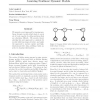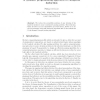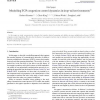1404 search results - page 51 / 281 » Dynamic Scale-Space Theories |
CG
2002
Springer
13 years 10 months ago
2002
Springer
It is a major source of contention in brain dynamics as to whether the electrical rhythms of the brain show signs of chaos. Here we discuss evidence for the existence of chaos in ...
ICML
2009
IEEE
14 years 11 months ago
2009
IEEE
We present a novel approach for learning nonlinear dynamic models, which leads to a new set of tools capable of solving problems that are otherwise difficult. We provide theory sh...
SEFM
2003
IEEE
14 years 4 months ago
2003
IEEE
We propose a formal model of trust informed by the Global Computing scenario and focusing on the aspects of trust formation, evolution, and propagation. The model is based on a no...
CADE
1999
Springer
14 years 3 months ago
1999
Springer
We reduce the provability problem of any formula of the Lambek calculus to some context-free parsing problem. This reduction, which is based on non-commutative proof-net theory, al...
AUTOMATICA
2007
13 years 11 months ago
2007
In this paper we study communication networks that employ drop-tail queueing and additive-increase multiplicative-decrease (AIMD) congestion control algorithms. We show that the t...



